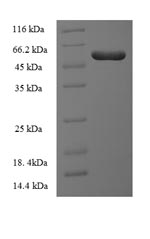This Human ILKAP recombinant protein was produced in E.coli, where the gene sequence encoding Human ILKAP (1-392aa) was expressed with the N-terminal 6xHis-SUMO tag. The purity of this ILKAP protein was greater than 90% by SDS-PAGE.
ILKAP is a serine/threonine phosphatase that is involved in extracellular matrix and intracellular signaling. It interacts with another protein called Integrin-Linked Kinase (ILK). ILK acts as a bridge between the extracellular matrix and intracellular signaling, while ILKAP is responsible for controlling the activity of ILK. This interaction is crucial for regulating biological processes such as cell adhesion, migration, proliferation, and survival. Studies suggest that ILKAP may have a tumor-suppressive role. The expression levels of ILKAP are associated with the progression and prognosis of various cancers, including breast cancer, colorectal cancer, and prostate cancer. ILKAP can inhibit the growth and spread of tumor cells by regulating processes such as cell adhesion, proliferation, and apoptosis. ILKAP is involved in multiple signaling pathways, including the Wnt/β-catenin signaling pathway and the Akt signaling pathway, which are essential for cell growth, differentiation, and survival.






